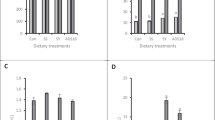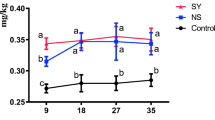Abstract
A 16-week experiment was conducted to compare effects of various levels of sodium selenite (SS) and Se-enriched yeast (SY), on the whole-egg Se content and hen’s productivity. One hundred Shaver 579 hens, 27 weeks old, were placed on one of five experimental treatments. Each treatment was replicated four times with five hens per cage. Treatments consisted of feeding a low Se diet without supplementation (basal diet) or basal diet with one of two levels of supplemented Se (0.4 or 0.8 mg/kg) supplied by SS or SY. All supplemented treatments had significantly higher whole-egg Se concentration from basal diet (P < 0.05). On the same supplemented level, hens fed on SY had higher egg Se content from hens feed on SS (P < 0.001). No effects of dietary treatments on egg weight, percentages of dirty and cracked egg, and feed intake and conversion of feed were observed throughout the trial (P < 0.05). In the first 8 weeks, there was no significant difference (P < 0.05) in hen-day egg production among treatments. From the ninth week on to the end of the trial, supplementation of SY to hen’s diet resulted in a higher egg production than SS (P < 0.01).
Similar content being viewed by others
References
The Commission of the European Communities (2007) Regulation (EC) No 1831/2003, Community Register of Feed Additives Rev. 16. In: Official Journal of the European Union, L146, pp 14–16.
FDA (2003) 21 CFR 573.920 Food additives permitted in feed and drinking water of animals: selenium, amended at Fed Regis 68:52339–52340.
Kelly MP, Power RF (1995) Fractionation and identification of the major selenium containing compounds in selenized yeast. J Dairy Sci 78(Suppl. 1): 237.
Paton ND, Cantor AH, Pescatore AJ, Ford MJ, Smith CA (2002) The Effect of Dietary Selenium Source and Level on the Uptake of Selenium by Developing Chick Embryos. Poult Sci 81:1548–1554.
Payne RL, Lavergne TK, Southern LL (2005) Effect of Inorganic Versus Organic Selenium on Hen Production and Egg Selenium Concentration. Poult Sci 84: 232–237.
Cantor AH (1997) The role of selenium in poultry nutrition. In: Lyons TP, Jacques KA (eds) Biotechnology in the Feed Industry: Proc. Alltech’s 13th Annual Symposium, Nottingham University Press, Nottingham, pp 155–164.
Utterback PL, Parsons CM, Yoon I, Butler J (2005) Effect of supplementing selenium yeast in diets of laying hens on egg selenium content. Poult Sci 84:1900–1901.
Pan C, Huang K, Zhao Y, Qin S, Chen F, Hu Q (2007) Effect of selenium source and level in hen’s diet on tissue selenium deposition and egg selenium concentrations. J Agric Food Chem 55:1027–32.
ISA (2005) Shaver-579 Layer Management Guide. Annex. ISA SAS Saint-Brieuc, France, 1–12.
Munns RK, Holland DC (1971) Determination of mercury in fish by flameless atomic absorption: a collaborative study. J Assoc Off Anal Chem 54: 202–5.
National Research Council (1994) Nutrient Requirements of Poultry. 9th rev. ed., National Academy Press, Washington pp 19–34.
Paton ND, Cantor AH, Pescatore AJ, Ford MJ (2000) Effect of dietary selenium source, level of inclusion and length of storage on internal quality and shell strength of eggs. Poult Sci 79 (Suppl. 1): 75.
Paton ND, Cantor AH, Pescatore AJ, Ford MJ (2000) Effect of dietary selenium source and storage on internal quality and shell strength of eggs. Poult Sci 79 (Suppl. 1): 116.
Renema RA (2004) Reproductive responses to Sel-Plex® organic selenium in male and female broiler breeders: impact on production traits and hatchability. In: Lyons TP, Jacques KA (eds) Biotechnology in the Feed Industry: Proc. Alltech’s 20th Annual Symposium, Nottingham University Press, Nottingham, pp 81–92.
Surai PF (2002) Selenium in poultry nutrition 1. Antioxidant properties, deficiency and toxicity. World’s Poult Sci J 58:333–346.
Akulov AV, Minina LA, Andreev MN, Tomskikh YUI, Bronnikova KA, Korenikov IP (1972) Experimental selenium poisoning in hens. Sel`skokhozyaistvennaya Biologiya 7: 430–436.
Wolffram S (1999) Absorption and metabolism of selenium: differences between inorganic and organic sources. In: Lyons TP, Jacques KA (eds) Biotechnology in the Feed Industry: Proc. Alltech’s 15th Annual Symposium, Nottingham University Press, Nottingham, pp 547–566.
Daniels LA (1996) Selenium metabolism and bioavailability. Biol Trace Elem Res 54:185–199.
Golubkina NA, Papazyan TT (2006) Selenium distribution in eggs of avian species. Comp Biochem Physiol, Part B 145:384–388.
Author information
Authors and Affiliations
Corresponding author
Rights and permissions
About this article
Cite this article
Pavlović, Z., Miletić, I., Jokić, Ž. et al. The Effect of Dietary Selenium Source and Level on Hen Production and Egg Selenium Concentration. Biol Trace Elem Res 131, 263–270 (2009). https://doi.org/10.1007/s12011-009-8369-y
Received:
Accepted:
Published:
Issue Date:
DOI: https://doi.org/10.1007/s12011-009-8369-y




